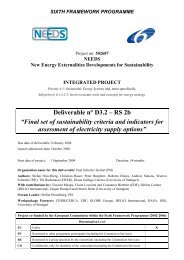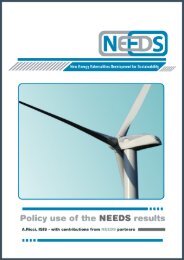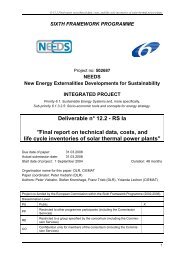Generation, of the energy carrier HYDROGEN In context ... - needs
Generation, of the energy carrier HYDROGEN In context ... - needs
Generation, of the energy carrier HYDROGEN In context ... - needs
You also want an ePaper? Increase the reach of your titles
YUMPU automatically turns print PDFs into web optimized ePapers that Google loves.
NyOrka Page 25 12/18/2008Table 10 <strong>In</strong>formation on size and amount <strong>of</strong> <strong>energy</strong> needed to run four different sizes <strong>of</strong> hydrogenstations.Size <strong>of</strong> stations60 Nm3 130 Nm3 485 Nm3 970 Nm3*INPUTProduction capacity 60 130 485 970 Nm3/hB, Energy costSpecific <strong>energy</strong> constant 5 5 5 5 kWh/Nm3Annual operational hours<strong>of</strong> grid 8.136 8.136 8.136 8.136 hours/year<strong>In</strong>stalled power 0,3 0,65 2,425 4,85 MWEnergy consumption 2.441 5.288 19.730 39.460 MWhAmount <strong>of</strong> hydrogenproduced per year 43.886 95.085 354.742 709.484 KgAnnual max number <strong>of</strong>passenger cars serviced 281 610 2.274 4.548To construct hydrogen stations in <strong>the</strong> optimal order, <strong>the</strong> overall electric distributionsystem has to be investigated; what is <strong>the</strong> current use, <strong>the</strong> overall system capacity and can<strong>the</strong> high Voltage cables provide enough electricity to <strong>the</strong> ideal locations. Is <strong>the</strong> fullcapacity already in use or is <strong>the</strong>re room for additional power transmission? The studyonly maps whe<strong>the</strong>r <strong>the</strong> areas’ electric grid networks can handle <strong>the</strong> required extradistribution or how it may be changed to fit <strong>the</strong> needed carrying capacity. The resultsfrom Reykjavik are presented in tables 5 and 6. <strong>In</strong> this case <strong>the</strong> grid has been built todeliver on peak demand (<strong>the</strong> 24 th <strong>of</strong> Dec in <strong>the</strong> afternoon!) and is <strong>the</strong>refore ready totransport electricity to planned hydrogen stations in times <strong>of</strong> low demand, but <strong>the</strong> grid<strong>needs</strong> to be reinforced if <strong>the</strong> demand increases considerably. The maximum demand ismeasured at 77 A, but <strong>the</strong> grid is built to deliver 320 A. The unused capacity surplus is178 A using 80% load.Table 11 Needed number and size <strong>of</strong> new transformers within Reykjavik’s grid system if hydrogen isproduced on site near main transport routes.Production capacity 60 130 485 970 Nm^3/hCurrent 433,0 938,2 3.500,2 7.000,4 ATransformers size 1 315 800 1250 1600 kVA2 1250 1600 kVA3 1250 kVA4 500 kVAMax current obtained 455 1155 3608 7144 AEstablishing a hydrogen station in one location evidently draws <strong>energy</strong> from <strong>the</strong> wholesystem, and <strong>the</strong>refore shuts out <strong>the</strong> opportunity <strong>of</strong> building a second one in close vicinity<strong>of</strong> <strong>the</strong> first one. <strong>In</strong> all cases, medium to large electrolytic hydrogen stations proved to be







